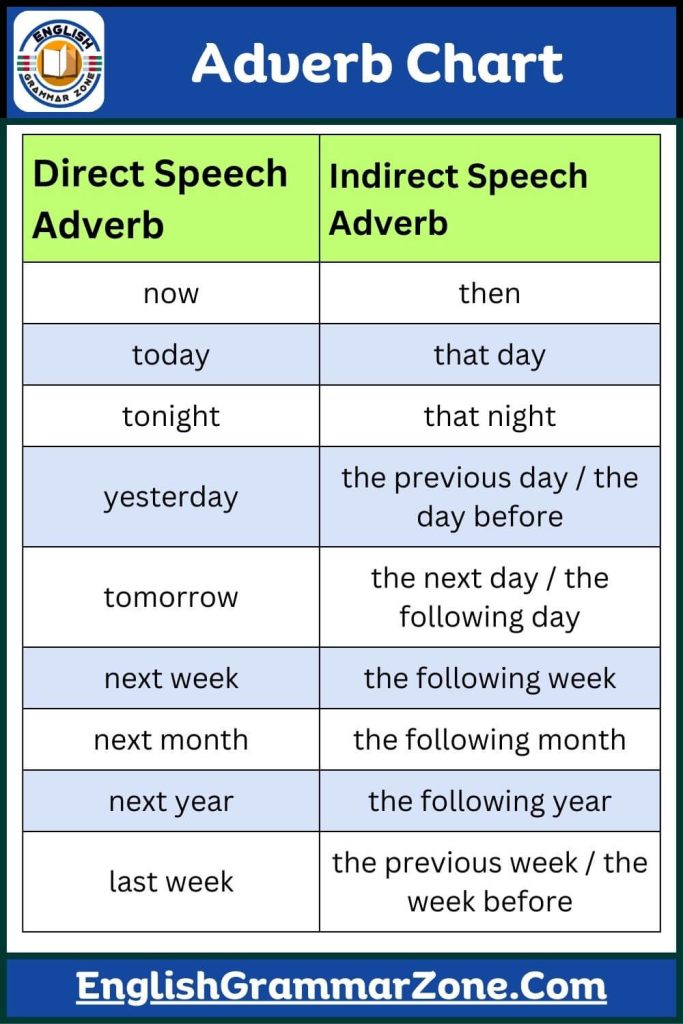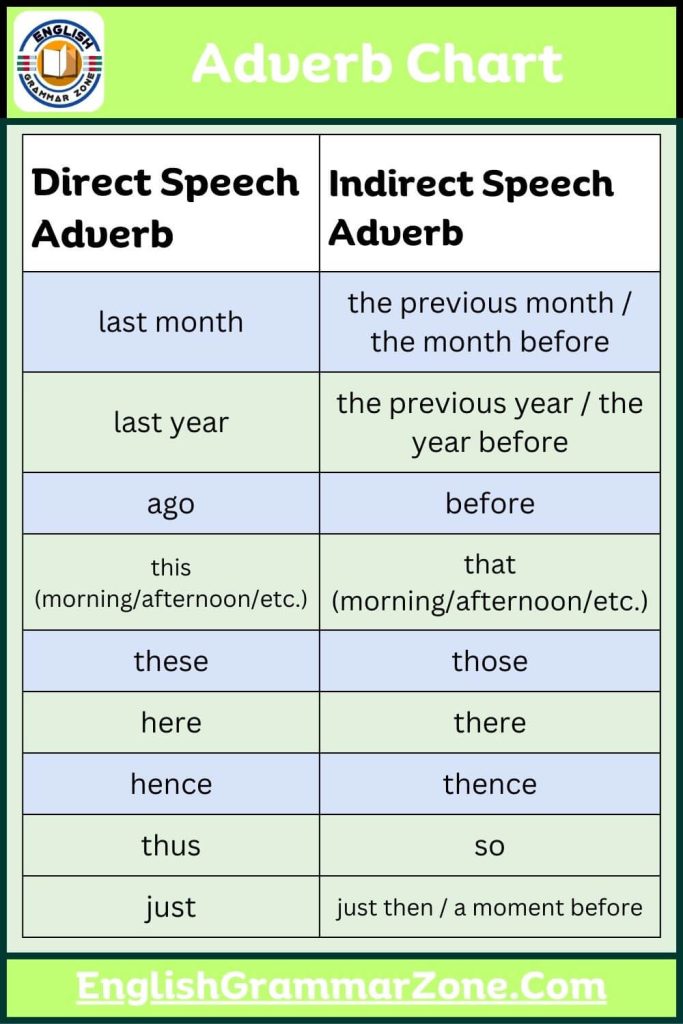Understanding Adverb Change in Direct and Indirect Speech is essential for mastering reported speech in English. When converting a sentence from direct to indirect speech, certain adverbs of time and place change to reflect the shift in perspective. In this post, you’ll learn the common adverb changes, along with easy-to-follow examples to help you use them correctly. Whether you’re a beginner or just need a quick refresher, this guide will make learning reported speech simple and clear.

Adverb Change In Direct And Indirect Speech
| Direct Speech Adverb | Indirect Speech Adverb |
| now | then |
| today | that day |
| tonight | that night |
| yesterday | the previous day / the day before |
| tomorrow | the next day / the following day |
| next week | the following week |
| next month | the following month |
| next year | the following year |
| last week | the previous week / the week before |
| last month | the previous month / the month before |
| last year | the previous year / the year before |
| ago | before |
| this (morning/afternoon/etc.) | that (morning/afternoon/etc.) |
| these | those |
| here | there |
| hence | thence |
| thus | so |
| just | just then / a moment before |
| before | earlier |
Rules for Changing Direct Speech to Indirect Speech
Converting direct speech (quoted speech) into indirect speech (reported speech) involves several key rules and adjustments. Below are detailed rules to help you understand and apply this concept effectively:
- Reporting Verb:
- Identify the reporting verb (e.g., said, told, asked, explained). This verb introduces the reported speech and often dictates the structure of the indirect speech sentence.
- Pronoun Changes:
- Change the pronouns according to the subject and object of the reporting clause:
- I → he/she
- You → he/she/they
- We → they
- Me → him/her
- My → his/her
- Our → their
- Mine → his/hers
- Us → them
- Change the pronouns according to the subject and object of the reporting clause:
- Tense Changes:
- Adjust the verb tense as follows:
- Present Simple → Past Simple
- Present Continuous → Past Continuous
- Present Perfect → Past Perfect
- Past Simple → Past Perfect
- Past Continuous → Past Perfect Continuous
- Future Simple (will) → Conditional (would)
- Future Continuous → Conditional Continuous
- Modal verbs (can, may, must, etc.) may change based on context.
- Adjust the verb tense as follows:
- Adverbial Changes:
- Modify adverbs of time and place accordingly:
- Now → then
- Today → that day
- Tonight → that night
- Yesterday → the previous day / the day before
- Tomorrow → the next day / the following day
- Next week/month/year → the following week/month/year
- Last week/month/year → the previous week/month/year
- Ago → before
- Here → there
- Modify adverbs of time and place accordingly:
- Other Changes:
- Make necessary changes to other elements like demonstratives (this → that, these → those) and adverbs of manner (here → there, thus → so).
Example sentences
Direct Speech:
- He said, “I am reading a book now.”
- She said, “We visited the museum last week.”
- They said, “We will go to the beach tomorrow.”
- John said, “I met him here.”
- Mary said, “I am leaving tonight.”
Indirect Speech:
- He said that he was reading a book then.
- She said that they had visited the museum the previous week.
- They said that they would go to the beach the next day.
- John said that he had met him there.
- Mary said that she was leaving that night.

FAQs on Adverb Change in Direct and Indirect Speech
1. How to change adverbs in reported speech?
When converting direct speech into indirect speech, adverbs of time and place often change to reflect the shift in perspective. Here are some common changes:
- Now → Then
- Today → That day
- Yesterday → The previous day
- Tomorrow → The next day
- Here → There
- This → That
For example:
Direct: She said, “I am studying now.”
Indirect: She said that she was studying then.
2. What are 10 examples of direct and indirect speech?
Here are 10 examples illustrating the changes in adverbs:
- Direct: He said, “I will come tomorrow.”
Indirect: He said that he would come the next day. - Direct: She said, “I met him yesterday.”
Indirect: She said that she had met him the previous day. - Direct: They said, “We are going now.”
Indirect: They said that they were going then. - Direct: He said, “I have an appointment today.”
Indirect: He said that he had an appointment that day. - Direct: She said, “I was here an hour ago.”
Indirect: She said that she had been there an hour before. - Direct: Tom said, “This is my book.”
Indirect: Tom said that that was his book. - Direct: They said, “We will go there.”
Indirect: They said that they would go there. - Direct: She said, “I saw him last week.”
Indirect: She said that she had seen him the previous week. - Direct: He said, “I will visit you next month.”
Indirect: He said that he would visit me the following month. - Direct: She said, “My father was here.”
Indirect: She said that her father had been there.
3. Which word will be changed from direct to indirect speech?
Words that indicate time, place, and demonstratives (this, that) often change in indirect speech. Here are the most common transformations:
- Now → Then
- Today → That day
- Yesterday → The previous day
- Tomorrow → The next day
- Next week → The following week
- Last month → The previous month
- Here → There
- This → That
- These → Those

